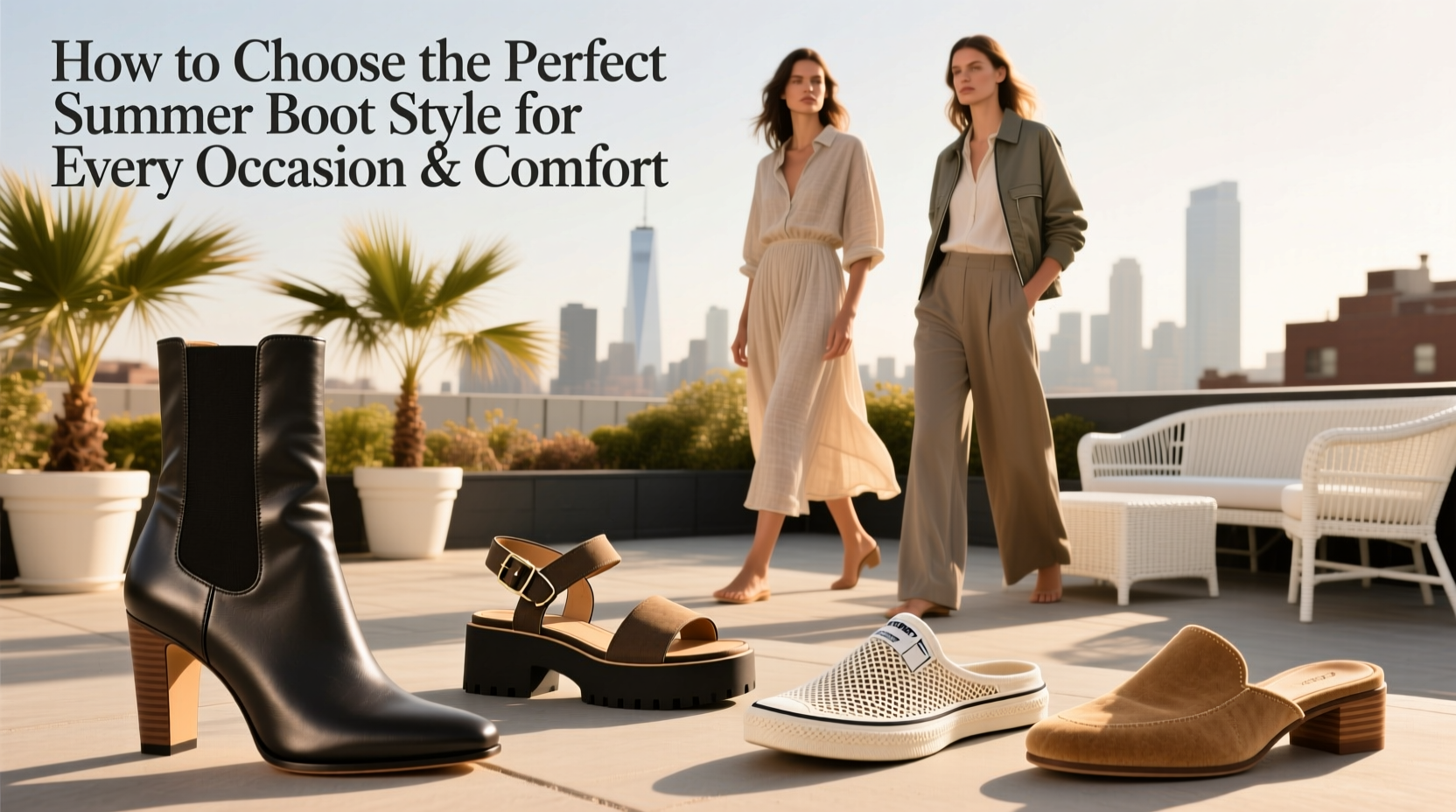As temperatures rise and wardrobes shift toward lighter fabrics, many overlook one essential footwear category: summer boots. While traditional boots are associated with colder months, modern designs now offer breathable materials, ventilated construction, and sleek silhouettes that make them ideal for warm weather. The key lies in choosing styles that balance function, fashion, and foot health. Whether you're navigating city streets, attending outdoor events, or hiking coastal trails, the right summer boot can elevate both your look and comfort.
Understanding Summer Boot Materials for Breathability

The foundation of a comfortable summer boot is its material. Unlike heavy leather or rubber used in winter, summer-friendly options prioritize airflow and moisture management. Here’s what to look for:
- Perforated Leather: Offers durability while allowing air circulation through tiny laser-cut holes. Ideal for urban settings where polished appearance matters.
- Mesh Panels: Integrated into synthetic uppers, mesh enhances ventilation without sacrificing structure. Common in hybrid hiking-style boots.
- Suede (Lightweight): Naturally breathable but requires protection from moisture. Best for dry climates and evening wear.
- Canvas: A classic choice—light, airy, and easy to clean. Often found in low-cut chukka or desert boot styles.
- Eco-Friendly Textiles: Brands now use recycled PET or plant-based fibers like eucalyptus, which wick sweat and resist odor.
“Footwear designed for warmth often traps heat and promotes bacterial growth. In summer, breathability isn’t just about comfort—it’s about foot hygiene.” — Dr. Lena Torres, Podiatrist & Footwear Consultant
Matching Boot Style to Occasion and Environment
Summer boots aren't one-size-fits-all. Different activities demand different features. Choosing wisely ensures you stay supported, cool, and appropriately dressed.
| Occasion | Recommended Boot Style | Key Features | Avoid |
|---|---|---|---|
| Casual City Wear | Chukka or Desert Boots | Canvas or suede, minimal lining, flexible sole | Heavy tread, insulated shafts |
| Hiking or Outdoor Trails | Ventilated Hiking Boots | Breathable mesh, ankle support, quick-dry lining | Fully sealed waterproof membranes (unless rain expected) |
| Beach Resorts / Coastal Areas | Water-Resistant Chelsea Boots | Drainage ports, quick-dry footbed, anti-slip soles | Full-grain leather, non-draining design |
| Outdoor Events (Festivals, Weddings) | Lightweight Ankle Boots | Stylish finish, cushioned midsole, moderate heel | Dark colors that absorb heat |
| Commuting in Humid Climates | Urban Hybrid Boots | Antimicrobial lining, shock absorption, slip-resistant outsole | Non-ventilated uppers |
Real Example: From Office to Evening Outdoors
Take Mark, a marketing executive based in Miami. His workweek includes client meetings downtown and weekend beach gatherings. He once wore full-leather brogues to a seaside bonfire—only to find they retained sand and moisture, leading to cracked leather and discomfort. After switching to a pair of taupe canvas chelseas with neoprene padding and drainage slits, he could walk across damp grass, sit by the fire, and return home without damage or fatigue. The same pair worked with tailored shorts during daytime meetings, proving versatility matters as much as climate adaptation.
Step-by-Step Guide to Selecting Your Ideal Summer Boot
- Assess Your Daily Activities: Track your weekly routine—do you walk more than 5 miles? Stand for hours? Attend formal events?
- Determine Climate Conditions: High humidity demands moisture management; arid heat calls for UV-resistant materials.
- Measure Your Feet Late in the Day: Feet swell slightly after activity, giving a truer fit reading.
- Try On With Seasonal Socks: Wear lightweight cotton or performance socks when testing boots.
- Walk on Simulated Surfaces: Test uphill inclines, flat floors, and uneven terrain if possible.
- Evaluate Break-in Time: Some boots need days to mold; others are ready immediately. Choose accordingly based on urgency.
- Check Return Policy: Especially important for online purchases where fit can’t be confirmed instantly.
Comfort Essentials: Fit, Support, and Long-Term Wearability
No matter how stylish, a boot that pinches, slips, or lacks arch support will fail in summer conditions. Heat amplifies discomfort, making proper ergonomics critical.
Look for these structural elements:
- Contoured Footbeds: Mold to your arch and reduce pressure points during extended wear.
- Heel Counter Stability: A firm back cup prevents ankle roll and provides structure without stiffness.
- Flexible Outsoles: Rubber or EVA compounds that bend with your stride, not against it.
- Toe Box Room: Enough space to wiggle toes—tight boxes encourage blisters and fungal issues.
Width is often overlooked. Many brands now offer wide (W) or extra-wide (XW) versions. If you have bunions or flat feet, this small adjustment can transform all-day comfort.
Do’s and Don’ts at a Glance
| Action | Do | Don’t |
|---|---|---|
| Fitting | Shop in the evening when feet are largest | Size based solely on morning measurements |
| Cleaning | Use pH-balanced wipes daily; deep clean weekly | Soak in water or use harsh detergents |
| Storage | Keep in a cool, ventilated area with cedar inserts | Leave in direct sunlight or enclosed plastic bins |
| Break-In | Wear for increasing intervals over 3–5 days | Wear new boots all day on rough terrain immediately |
FAQ: Common Questions About Summer Boots
Can I wear boots in 90°F+ (32°C+) weather?
Yes—provided they’re designed for heat. Lightweight materials, ventilation zones, and moisture-wicking linings make high-temp wear feasible. Avoid full-grain leather unless perforated. Opt for light colors that reflect sunlight rather than absorb it.
Are waterproof boots suitable for summer?
Only in specific cases. Traditional waterproof membranes (like Gore-Tex) trap heat and reduce breathability. However, newer \"water-resistant\" treatments allow vapor escape while shedding light rain. Use fully waterproof boots only if frequent downpours are expected.
How do I prevent odor in summer boots?
Rotate between two or more pairs to allow 24-hour drying time. Use antimicrobial insoles and apply foot powders before wearing. At night, insert odor-absorbing charcoal bags or baking soda sachets.
Final Checklist Before You Buy
- ✅ Lightweight Upper Material?
- Canvas, perforated leather, or mesh present.
- ✅ Ventilation Zones?
- Look for side gills, perforations, or open-weave panels.
- ✅ Moisture-Wicking Lining?
- Prevents sweat buildup and reduces blister risk.
- ✅ Flexible Sole?
- Bend the boot—there should be natural give at the ball of the foot.
- ✅ Secure Fit Without Pressure?
- No heel slip, no pinching on toes or ankles.
- ✅ Appropriate for Intended Use?
- Matches your primary activity—walking, standing, hiking, etc.
Conclusion: Step Into Summer With Confidence
Choosing the perfect summer boot isn’t about compromising comfort for style—it’s about finding harmony between the two. Today’s market offers innovative solutions that let you wear boots year-round, provided you select thoughtfully. Prioritize breathable materials, anatomical support, and situational appropriateness. Try before you buy, care for your investment, and rotate styles to extend longevity. With the right pair, you’ll move through summer with confidence, ease, and undeniable flair.









 浙公网安备
33010002000092号
浙公网安备
33010002000092号 浙B2-20120091-4
浙B2-20120091-4
Comments
No comments yet. Why don't you start the discussion?